Literature Review: Glucose Control and Diabetic Neuropathy Effects
VerifiedAdded on 2023/01/23
|6
|2039
|44
Literature Review
AI Summary
This literature review examines the relationship between strict glucose control and the development of diabetic neuropathy in both Type 1 (T1DM) and Type 2 (T2DM) diabetes. The review synthesizes findings from various studies published between 2008 and 2018, exploring the impact of glycemic management on the onset and progression of neuropathy. Key findings suggest that strict glucose control may help prevent or postpone neuropathy, particularly in T1DM patients, although the benefits in T2DM appear less pronounced. The review highlights the importance of early intervention and emphasizes the need for further research to address confounding factors and identify other modifiable risk factors for diabetic neuropathy. The review also considers the potential adverse effects of intensive glucose control, especially in T2DM, and the need for a balanced approach to diabetes management, considering individual patient characteristics and the overall risk-benefit ratio. Ultimately, the review underscores the importance of optimizing glucose control to prevent or slow the progression of diabetic neuropathy, along with the necessity of ongoing research to refine treatment strategies and improve patient outcomes.
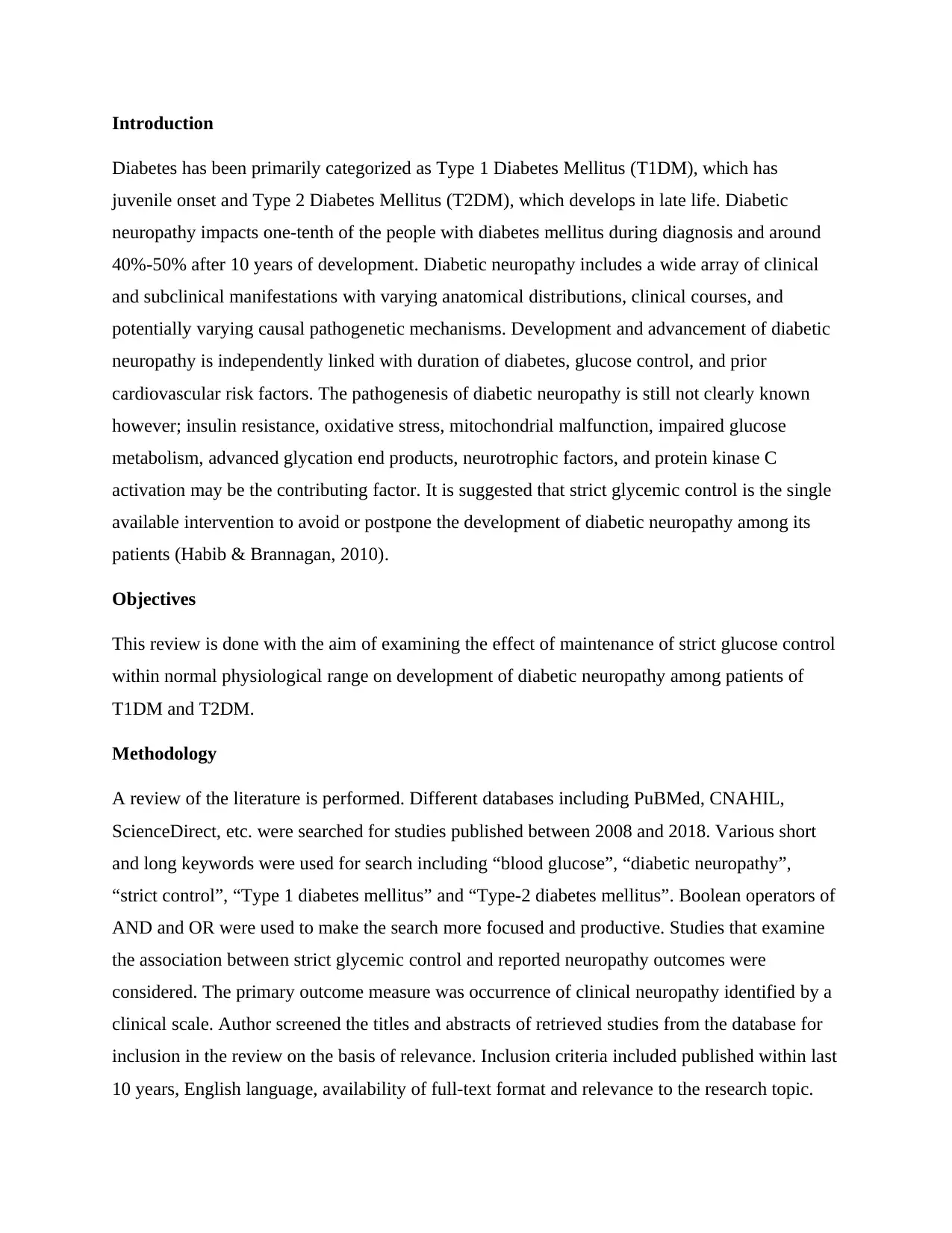
Introduction
Diabetes has been primarily categorized as Type 1 Diabetes Mellitus (T1DM), which has
juvenile onset and Type 2 Diabetes Mellitus (T2DM), which develops in late life. Diabetic
neuropathy impacts one-tenth of the people with diabetes mellitus during diagnosis and around
40%-50% after 10 years of development. Diabetic neuropathy includes a wide array of clinical
and subclinical manifestations with varying anatomical distributions, clinical courses, and
potentially varying causal pathogenetic mechanisms. Development and advancement of diabetic
neuropathy is independently linked with duration of diabetes, glucose control, and prior
cardiovascular risk factors. The pathogenesis of diabetic neuropathy is still not clearly known
however; insulin resistance, oxidative stress, mitochondrial malfunction, impaired glucose
metabolism, advanced glycation end products, neurotrophic factors, and protein kinase C
activation may be the contributing factor. It is suggested that strict glycemic control is the single
available intervention to avoid or postpone the development of diabetic neuropathy among its
patients (Habib & Brannagan, 2010).
Objectives
This review is done with the aim of examining the effect of maintenance of strict glucose control
within normal physiological range on development of diabetic neuropathy among patients of
T1DM and T2DM.
Methodology
A review of the literature is performed. Different databases including PuBMed, CNAHIL,
ScienceDirect, etc. were searched for studies published between 2008 and 2018. Various short
and long keywords were used for search including “blood glucose”, “diabetic neuropathy”,
“strict control”, “Type 1 diabetes mellitus” and “Type-2 diabetes mellitus”. Boolean operators of
AND and OR were used to make the search more focused and productive. Studies that examine
the association between strict glycemic control and reported neuropathy outcomes were
considered. The primary outcome measure was occurrence of clinical neuropathy identified by a
clinical scale. Author screened the titles and abstracts of retrieved studies from the database for
inclusion in the review on the basis of relevance. Inclusion criteria included published within last
10 years, English language, availability of full-text format and relevance to the research topic.
Diabetes has been primarily categorized as Type 1 Diabetes Mellitus (T1DM), which has
juvenile onset and Type 2 Diabetes Mellitus (T2DM), which develops in late life. Diabetic
neuropathy impacts one-tenth of the people with diabetes mellitus during diagnosis and around
40%-50% after 10 years of development. Diabetic neuropathy includes a wide array of clinical
and subclinical manifestations with varying anatomical distributions, clinical courses, and
potentially varying causal pathogenetic mechanisms. Development and advancement of diabetic
neuropathy is independently linked with duration of diabetes, glucose control, and prior
cardiovascular risk factors. The pathogenesis of diabetic neuropathy is still not clearly known
however; insulin resistance, oxidative stress, mitochondrial malfunction, impaired glucose
metabolism, advanced glycation end products, neurotrophic factors, and protein kinase C
activation may be the contributing factor. It is suggested that strict glycemic control is the single
available intervention to avoid or postpone the development of diabetic neuropathy among its
patients (Habib & Brannagan, 2010).
Objectives
This review is done with the aim of examining the effect of maintenance of strict glucose control
within normal physiological range on development of diabetic neuropathy among patients of
T1DM and T2DM.
Methodology
A review of the literature is performed. Different databases including PuBMed, CNAHIL,
ScienceDirect, etc. were searched for studies published between 2008 and 2018. Various short
and long keywords were used for search including “blood glucose”, “diabetic neuropathy”,
“strict control”, “Type 1 diabetes mellitus” and “Type-2 diabetes mellitus”. Boolean operators of
AND and OR were used to make the search more focused and productive. Studies that examine
the association between strict glycemic control and reported neuropathy outcomes were
considered. The primary outcome measure was occurrence of clinical neuropathy identified by a
clinical scale. Author screened the titles and abstracts of retrieved studies from the database for
inclusion in the review on the basis of relevance. Inclusion criteria included published within last
10 years, English language, availability of full-text format and relevance to the research topic.
Paraphrase This Document
Need a fresh take? Get an instant paraphrase of this document with our AI Paraphraser
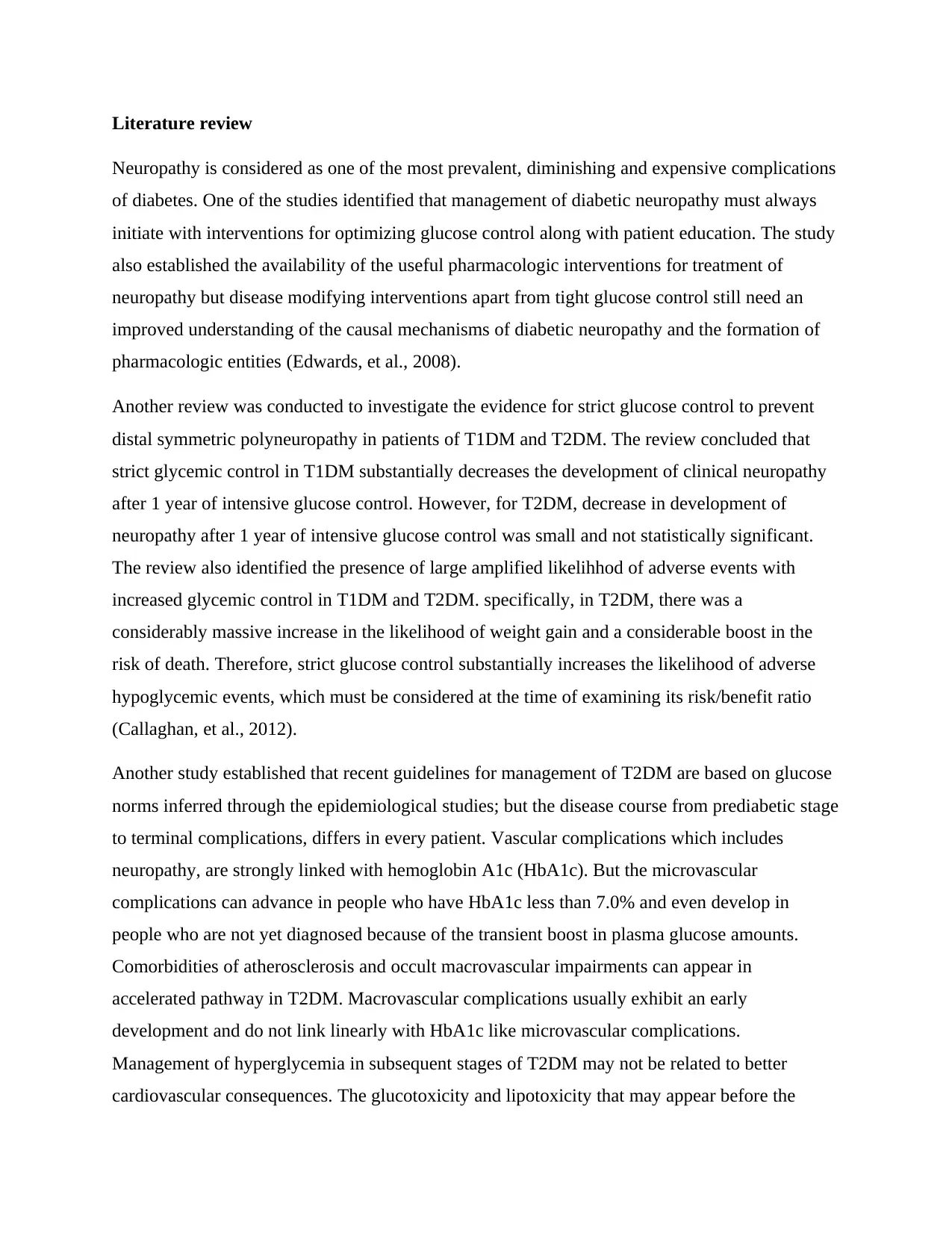
Literature review
Neuropathy is considered as one of the most prevalent, diminishing and expensive complications
of diabetes. One of the studies identified that management of diabetic neuropathy must always
initiate with interventions for optimizing glucose control along with patient education. The study
also established the availability of the useful pharmacologic interventions for treatment of
neuropathy but disease modifying interventions apart from tight glucose control still need an
improved understanding of the causal mechanisms of diabetic neuropathy and the formation of
pharmacologic entities (Edwards, et al., 2008).
Another review was conducted to investigate the evidence for strict glucose control to prevent
distal symmetric polyneuropathy in patients of T1DM and T2DM. The review concluded that
strict glycemic control in T1DM substantially decreases the development of clinical neuropathy
after 1 year of intensive glucose control. However, for T2DM, decrease in development of
neuropathy after 1 year of intensive glucose control was small and not statistically significant.
The review also identified the presence of large amplified likelihhod of adverse events with
increased glycemic control in T1DM and T2DM. specifically, in T2DM, there was a
considerably massive increase in the likelihood of weight gain and a considerable boost in the
risk of death. Therefore, strict glucose control substantially increases the likelihood of adverse
hypoglycemic events, which must be considered at the time of examining its risk/benefit ratio
(Callaghan, et al., 2012).
Another study established that recent guidelines for management of T2DM are based on glucose
norms inferred through the epidemiological studies; but the disease course from prediabetic stage
to terminal complications, differs in every patient. Vascular complications which includes
neuropathy, are strongly linked with hemoglobin A1c (HbA1c). But the microvascular
complications can advance in people who have HbA1c less than 7.0% and even develop in
people who are not yet diagnosed because of the transient boost in plasma glucose amounts.
Comorbidities of atherosclerosis and occult macrovascular impairments can appear in
accelerated pathway in T2DM. Macrovascular complications usually exhibit an early
development and do not link linearly with HbA1c like microvascular complications.
Management of hyperglycemia in subsequent stages of T2DM may not be related to better
cardiovascular consequences. The glucotoxicity and lipotoxicity that may appear before the
Neuropathy is considered as one of the most prevalent, diminishing and expensive complications
of diabetes. One of the studies identified that management of diabetic neuropathy must always
initiate with interventions for optimizing glucose control along with patient education. The study
also established the availability of the useful pharmacologic interventions for treatment of
neuropathy but disease modifying interventions apart from tight glucose control still need an
improved understanding of the causal mechanisms of diabetic neuropathy and the formation of
pharmacologic entities (Edwards, et al., 2008).
Another review was conducted to investigate the evidence for strict glucose control to prevent
distal symmetric polyneuropathy in patients of T1DM and T2DM. The review concluded that
strict glycemic control in T1DM substantially decreases the development of clinical neuropathy
after 1 year of intensive glucose control. However, for T2DM, decrease in development of
neuropathy after 1 year of intensive glucose control was small and not statistically significant.
The review also identified the presence of large amplified likelihhod of adverse events with
increased glycemic control in T1DM and T2DM. specifically, in T2DM, there was a
considerably massive increase in the likelihood of weight gain and a considerable boost in the
risk of death. Therefore, strict glucose control substantially increases the likelihood of adverse
hypoglycemic events, which must be considered at the time of examining its risk/benefit ratio
(Callaghan, et al., 2012).
Another study established that recent guidelines for management of T2DM are based on glucose
norms inferred through the epidemiological studies; but the disease course from prediabetic stage
to terminal complications, differs in every patient. Vascular complications which includes
neuropathy, are strongly linked with hemoglobin A1c (HbA1c). But the microvascular
complications can advance in people who have HbA1c less than 7.0% and even develop in
people who are not yet diagnosed because of the transient boost in plasma glucose amounts.
Comorbidities of atherosclerosis and occult macrovascular impairments can appear in
accelerated pathway in T2DM. Macrovascular complications usually exhibit an early
development and do not link linearly with HbA1c like microvascular complications.
Management of hyperglycemia in subsequent stages of T2DM may not be related to better
cardiovascular consequences. The glucotoxicity and lipotoxicity that may appear before the
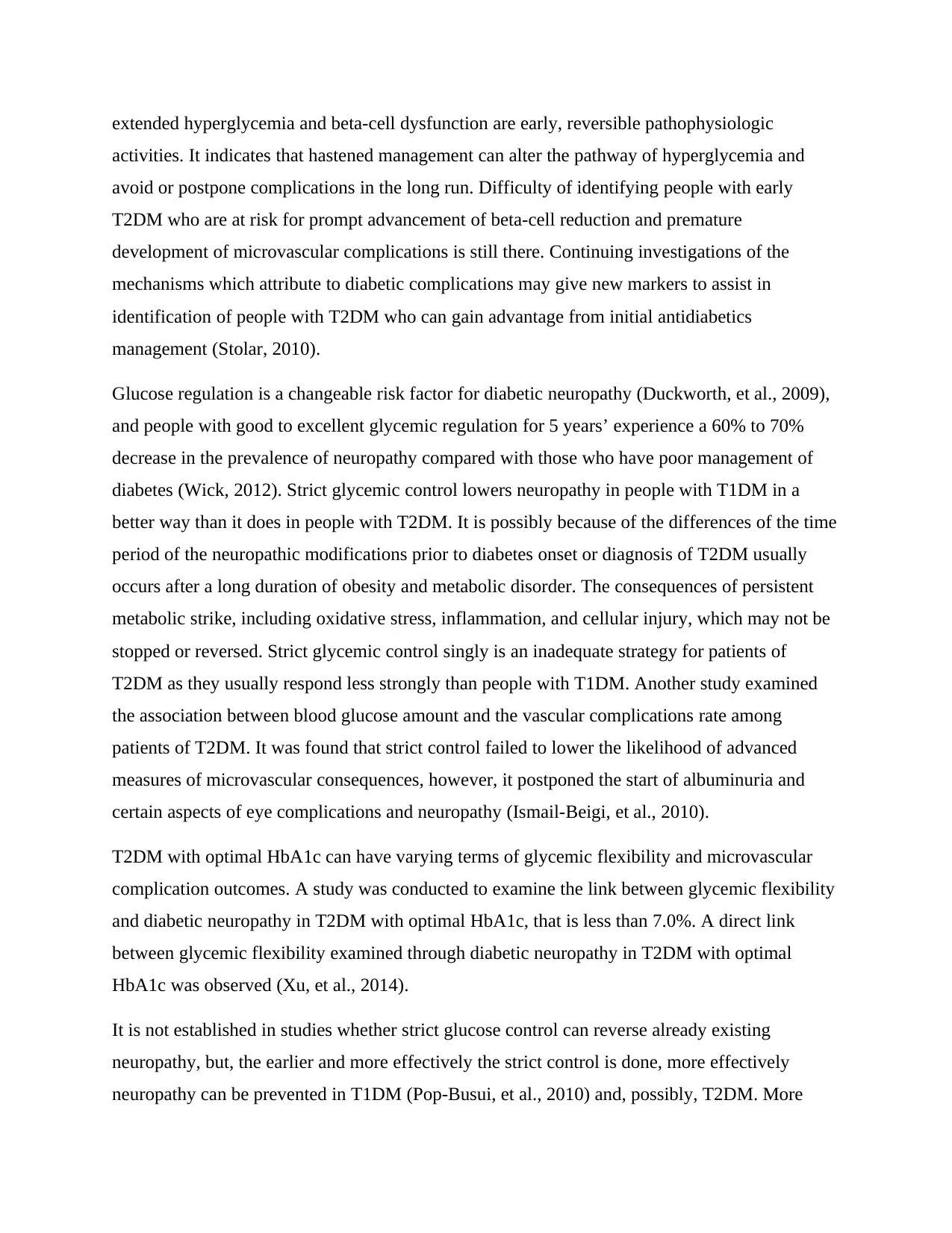
extended hyperglycemia and beta-cell dysfunction are early, reversible pathophysiologic
activities. It indicates that hastened management can alter the pathway of hyperglycemia and
avoid or postpone complications in the long run. Difficulty of identifying people with early
T2DM who are at risk for prompt advancement of beta-cell reduction and premature
development of microvascular complications is still there. Continuing investigations of the
mechanisms which attribute to diabetic complications may give new markers to assist in
identification of people with T2DM who can gain advantage from initial antidiabetics
management (Stolar, 2010).
Glucose regulation is a changeable risk factor for diabetic neuropathy (Duckworth, et al., 2009),
and people with good to excellent glycemic regulation for 5 years’ experience a 60% to 70%
decrease in the prevalence of neuropathy compared with those who have poor management of
diabetes (Wick, 2012). Strict glycemic control lowers neuropathy in people with T1DM in a
better way than it does in people with T2DM. It is possibly because of the differences of the time
period of the neuropathic modifications prior to diabetes onset or diagnosis of T2DM usually
occurs after a long duration of obesity and metabolic disorder. The consequences of persistent
metabolic strike, including oxidative stress, inflammation, and cellular injury, which may not be
stopped or reversed. Strict glycemic control singly is an inadequate strategy for patients of
T2DM as they usually respond less strongly than people with T1DM. Another study examined
the association between blood glucose amount and the vascular complications rate among
patients of T2DM. It was found that strict control failed to lower the likelihood of advanced
measures of microvascular consequences, however, it postponed the start of albuminuria and
certain aspects of eye complications and neuropathy (Ismail-Beigi, et al., 2010).
T2DM with optimal HbA1c can have varying terms of glycemic flexibility and microvascular
complication outcomes. A study was conducted to examine the link between glycemic flexibility
and diabetic neuropathy in T2DM with optimal HbA1c, that is less than 7.0%. A direct link
between glycemic flexibility examined through diabetic neuropathy in T2DM with optimal
HbA1c was observed (Xu, et al., 2014).
It is not established in studies whether strict glucose control can reverse already existing
neuropathy, but, the earlier and more effectively the strict control is done, more effectively
neuropathy can be prevented in T1DM (Pop-Busui, et al., 2010) and, possibly, T2DM. More
activities. It indicates that hastened management can alter the pathway of hyperglycemia and
avoid or postpone complications in the long run. Difficulty of identifying people with early
T2DM who are at risk for prompt advancement of beta-cell reduction and premature
development of microvascular complications is still there. Continuing investigations of the
mechanisms which attribute to diabetic complications may give new markers to assist in
identification of people with T2DM who can gain advantage from initial antidiabetics
management (Stolar, 2010).
Glucose regulation is a changeable risk factor for diabetic neuropathy (Duckworth, et al., 2009),
and people with good to excellent glycemic regulation for 5 years’ experience a 60% to 70%
decrease in the prevalence of neuropathy compared with those who have poor management of
diabetes (Wick, 2012). Strict glycemic control lowers neuropathy in people with T1DM in a
better way than it does in people with T2DM. It is possibly because of the differences of the time
period of the neuropathic modifications prior to diabetes onset or diagnosis of T2DM usually
occurs after a long duration of obesity and metabolic disorder. The consequences of persistent
metabolic strike, including oxidative stress, inflammation, and cellular injury, which may not be
stopped or reversed. Strict glycemic control singly is an inadequate strategy for patients of
T2DM as they usually respond less strongly than people with T1DM. Another study examined
the association between blood glucose amount and the vascular complications rate among
patients of T2DM. It was found that strict control failed to lower the likelihood of advanced
measures of microvascular consequences, however, it postponed the start of albuminuria and
certain aspects of eye complications and neuropathy (Ismail-Beigi, et al., 2010).
T2DM with optimal HbA1c can have varying terms of glycemic flexibility and microvascular
complication outcomes. A study was conducted to examine the link between glycemic flexibility
and diabetic neuropathy in T2DM with optimal HbA1c, that is less than 7.0%. A direct link
between glycemic flexibility examined through diabetic neuropathy in T2DM with optimal
HbA1c was observed (Xu, et al., 2014).
It is not established in studies whether strict glucose control can reverse already existing
neuropathy, but, the earlier and more effectively the strict control is done, more effectively
neuropathy can be prevented in T1DM (Pop-Busui, et al., 2010) and, possibly, T2DM. More
⊘ This is a preview!⊘
Do you want full access?
Subscribe today to unlock all pages.

Trusted by 1+ million students worldwide
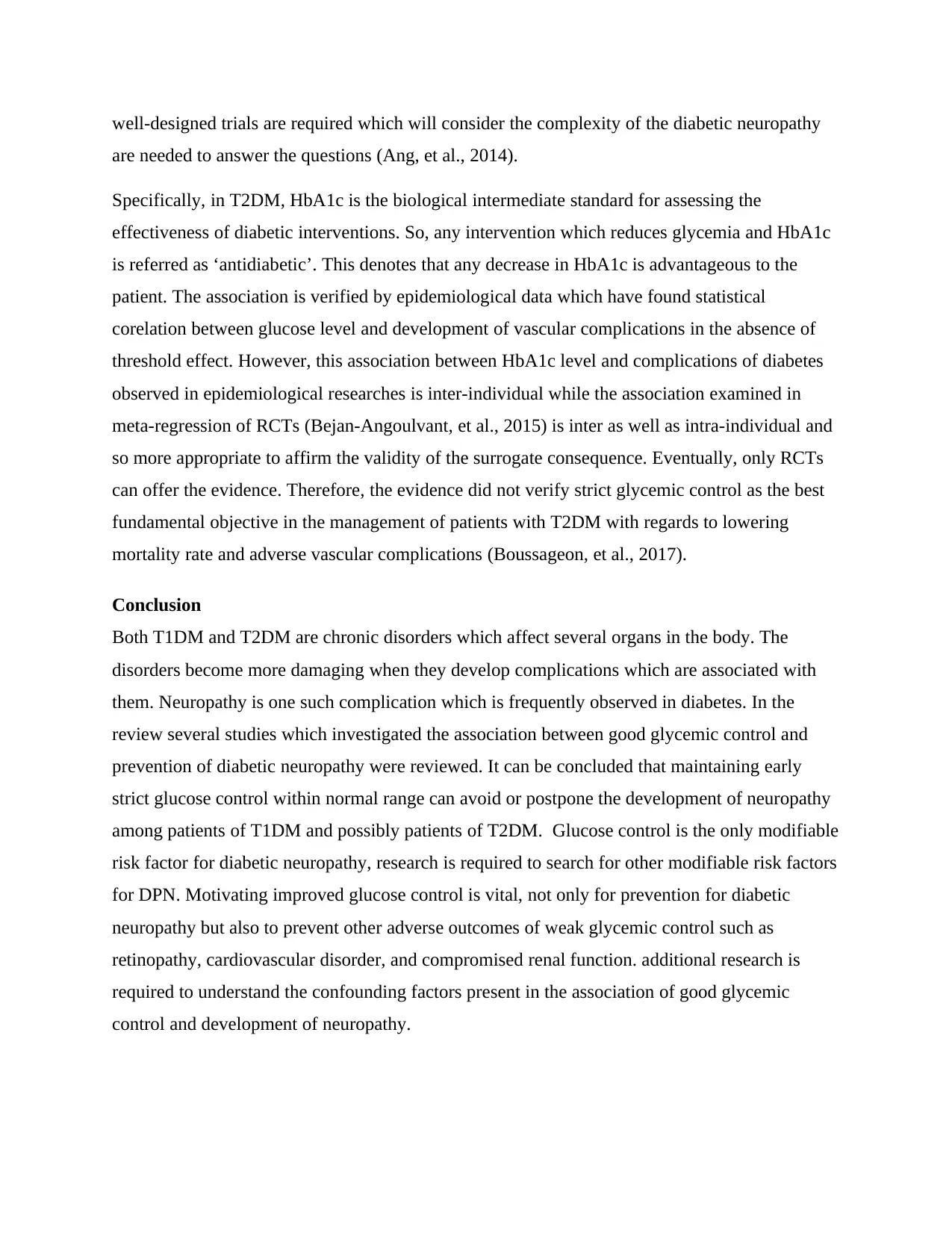
well-designed trials are required which will consider the complexity of the diabetic neuropathy
are needed to answer the questions (Ang, et al., 2014).
Specifically, in T2DM, HbA1c is the biological intermediate standard for assessing the
effectiveness of diabetic interventions. So, any intervention which reduces glycemia and HbA1c
is referred as ‘antidiabetic’. This denotes that any decrease in HbA1c is advantageous to the
patient. The association is verified by epidemiological data which have found statistical
corelation between glucose level and development of vascular complications in the absence of
threshold effect. However, this association between HbA1c level and complications of diabetes
observed in epidemiological researches is inter-individual while the association examined in
meta-regression of RCTs (Bejan-Angoulvant, et al., 2015) is inter as well as intra-individual and
so more appropriate to affirm the validity of the surrogate consequence. Eventually, only RCTs
can offer the evidence. Therefore, the evidence did not verify strict glycemic control as the best
fundamental objective in the management of patients with T2DM with regards to lowering
mortality rate and adverse vascular complications (Boussageon, et al., 2017).
Conclusion
Both T1DM and T2DM are chronic disorders which affect several organs in the body. The
disorders become more damaging when they develop complications which are associated with
them. Neuropathy is one such complication which is frequently observed in diabetes. In the
review several studies which investigated the association between good glycemic control and
prevention of diabetic neuropathy were reviewed. It can be concluded that maintaining early
strict glucose control within normal range can avoid or postpone the development of neuropathy
among patients of T1DM and possibly patients of T2DM. Glucose control is the only modifiable
risk factor for diabetic neuropathy, research is required to search for other modifiable risk factors
for DPN. Motivating improved glucose control is vital, not only for prevention for diabetic
neuropathy but also to prevent other adverse outcomes of weak glycemic control such as
retinopathy, cardiovascular disorder, and compromised renal function. additional research is
required to understand the confounding factors present in the association of good glycemic
control and development of neuropathy.
are needed to answer the questions (Ang, et al., 2014).
Specifically, in T2DM, HbA1c is the biological intermediate standard for assessing the
effectiveness of diabetic interventions. So, any intervention which reduces glycemia and HbA1c
is referred as ‘antidiabetic’. This denotes that any decrease in HbA1c is advantageous to the
patient. The association is verified by epidemiological data which have found statistical
corelation between glucose level and development of vascular complications in the absence of
threshold effect. However, this association between HbA1c level and complications of diabetes
observed in epidemiological researches is inter-individual while the association examined in
meta-regression of RCTs (Bejan-Angoulvant, et al., 2015) is inter as well as intra-individual and
so more appropriate to affirm the validity of the surrogate consequence. Eventually, only RCTs
can offer the evidence. Therefore, the evidence did not verify strict glycemic control as the best
fundamental objective in the management of patients with T2DM with regards to lowering
mortality rate and adverse vascular complications (Boussageon, et al., 2017).
Conclusion
Both T1DM and T2DM are chronic disorders which affect several organs in the body. The
disorders become more damaging when they develop complications which are associated with
them. Neuropathy is one such complication which is frequently observed in diabetes. In the
review several studies which investigated the association between good glycemic control and
prevention of diabetic neuropathy were reviewed. It can be concluded that maintaining early
strict glucose control within normal range can avoid or postpone the development of neuropathy
among patients of T1DM and possibly patients of T2DM. Glucose control is the only modifiable
risk factor for diabetic neuropathy, research is required to search for other modifiable risk factors
for DPN. Motivating improved glucose control is vital, not only for prevention for diabetic
neuropathy but also to prevent other adverse outcomes of weak glycemic control such as
retinopathy, cardiovascular disorder, and compromised renal function. additional research is
required to understand the confounding factors present in the association of good glycemic
control and development of neuropathy.
Paraphrase This Document
Need a fresh take? Get an instant paraphrase of this document with our AI Paraphraser
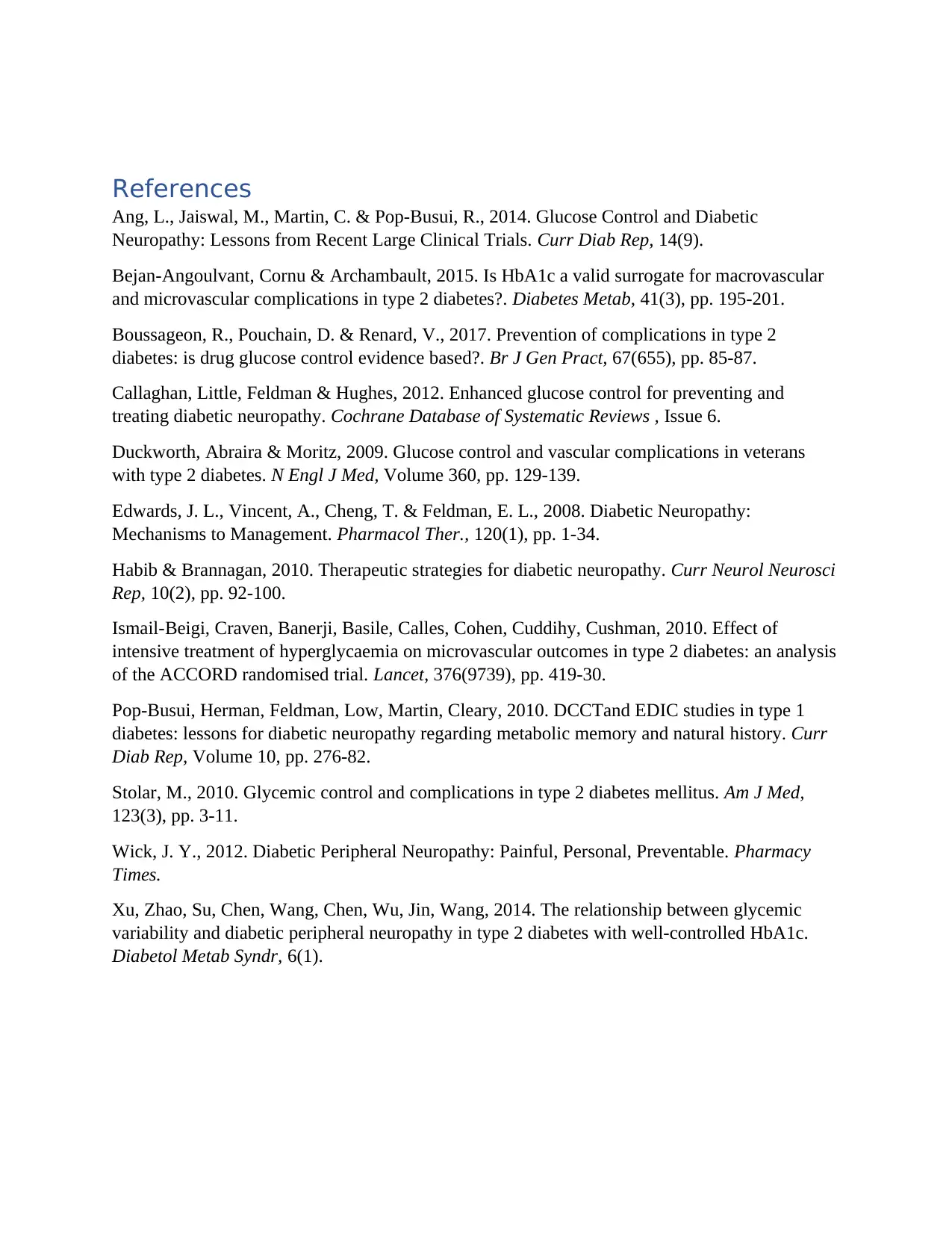
References
Ang, L., Jaiswal, M., Martin, C. & Pop-Busui, R., 2014. Glucose Control and Diabetic
Neuropathy: Lessons from Recent Large Clinical Trials. Curr Diab Rep, 14(9).
Bejan-Angoulvant, Cornu & Archambault, 2015. Is HbA1c a valid surrogate for macrovascular
and microvascular complications in type 2 diabetes?. Diabetes Metab, 41(3), pp. 195-201.
Boussageon, R., Pouchain, D. & Renard, V., 2017. Prevention of complications in type 2
diabetes: is drug glucose control evidence based?. Br J Gen Pract, 67(655), pp. 85-87.
Callaghan, Little, Feldman & Hughes, 2012. Enhanced glucose control for preventing and
treating diabetic neuropathy. Cochrane Database of Systematic Reviews , Issue 6.
Duckworth, Abraira & Moritz, 2009. Glucose control and vascular complications in veterans
with type 2 diabetes. N Engl J Med, Volume 360, pp. 129-139.
Edwards, J. L., Vincent, A., Cheng, T. & Feldman, E. L., 2008. Diabetic Neuropathy:
Mechanisms to Management. Pharmacol Ther., 120(1), pp. 1-34.
Habib & Brannagan, 2010. Therapeutic strategies for diabetic neuropathy. Curr Neurol Neurosci
Rep, 10(2), pp. 92-100.
Ismail-Beigi, Craven, Banerji, Basile, Calles, Cohen, Cuddihy, Cushman, 2010. Effect of
intensive treatment of hyperglycaemia on microvascular outcomes in type 2 diabetes: an analysis
of the ACCORD randomised trial. Lancet, 376(9739), pp. 419-30.
Pop-Busui, Herman, Feldman, Low, Martin, Cleary, 2010. DCCTand EDIC studies in type 1
diabetes: lessons for diabetic neuropathy regarding metabolic memory and natural history. Curr
Diab Rep, Volume 10, pp. 276-82.
Stolar, M., 2010. Glycemic control and complications in type 2 diabetes mellitus. Am J Med,
123(3), pp. 3-11.
Wick, J. Y., 2012. Diabetic Peripheral Neuropathy: Painful, Personal, Preventable. Pharmacy
Times.
Xu, Zhao, Su, Chen, Wang, Chen, Wu, Jin, Wang, 2014. The relationship between glycemic
variability and diabetic peripheral neuropathy in type 2 diabetes with well-controlled HbA1c.
Diabetol Metab Syndr, 6(1).
Ang, L., Jaiswal, M., Martin, C. & Pop-Busui, R., 2014. Glucose Control and Diabetic
Neuropathy: Lessons from Recent Large Clinical Trials. Curr Diab Rep, 14(9).
Bejan-Angoulvant, Cornu & Archambault, 2015. Is HbA1c a valid surrogate for macrovascular
and microvascular complications in type 2 diabetes?. Diabetes Metab, 41(3), pp. 195-201.
Boussageon, R., Pouchain, D. & Renard, V., 2017. Prevention of complications in type 2
diabetes: is drug glucose control evidence based?. Br J Gen Pract, 67(655), pp. 85-87.
Callaghan, Little, Feldman & Hughes, 2012. Enhanced glucose control for preventing and
treating diabetic neuropathy. Cochrane Database of Systematic Reviews , Issue 6.
Duckworth, Abraira & Moritz, 2009. Glucose control and vascular complications in veterans
with type 2 diabetes. N Engl J Med, Volume 360, pp. 129-139.
Edwards, J. L., Vincent, A., Cheng, T. & Feldman, E. L., 2008. Diabetic Neuropathy:
Mechanisms to Management. Pharmacol Ther., 120(1), pp. 1-34.
Habib & Brannagan, 2010. Therapeutic strategies for diabetic neuropathy. Curr Neurol Neurosci
Rep, 10(2), pp. 92-100.
Ismail-Beigi, Craven, Banerji, Basile, Calles, Cohen, Cuddihy, Cushman, 2010. Effect of
intensive treatment of hyperglycaemia on microvascular outcomes in type 2 diabetes: an analysis
of the ACCORD randomised trial. Lancet, 376(9739), pp. 419-30.
Pop-Busui, Herman, Feldman, Low, Martin, Cleary, 2010. DCCTand EDIC studies in type 1
diabetes: lessons for diabetic neuropathy regarding metabolic memory and natural history. Curr
Diab Rep, Volume 10, pp. 276-82.
Stolar, M., 2010. Glycemic control and complications in type 2 diabetes mellitus. Am J Med,
123(3), pp. 3-11.
Wick, J. Y., 2012. Diabetic Peripheral Neuropathy: Painful, Personal, Preventable. Pharmacy
Times.
Xu, Zhao, Su, Chen, Wang, Chen, Wu, Jin, Wang, 2014. The relationship between glycemic
variability and diabetic peripheral neuropathy in type 2 diabetes with well-controlled HbA1c.
Diabetol Metab Syndr, 6(1).

⊘ This is a preview!⊘
Do you want full access?
Subscribe today to unlock all pages.

Trusted by 1+ million students worldwide
1 out of 6
Related Documents
Your All-in-One AI-Powered Toolkit for Academic Success.
+13062052269
info@desklib.com
Available 24*7 on WhatsApp / Email
![[object Object]](/_next/static/media/star-bottom.7253800d.svg)
Unlock your academic potential
Copyright © 2020–2025 A2Z Services. All Rights Reserved. Developed and managed by ZUCOL.





